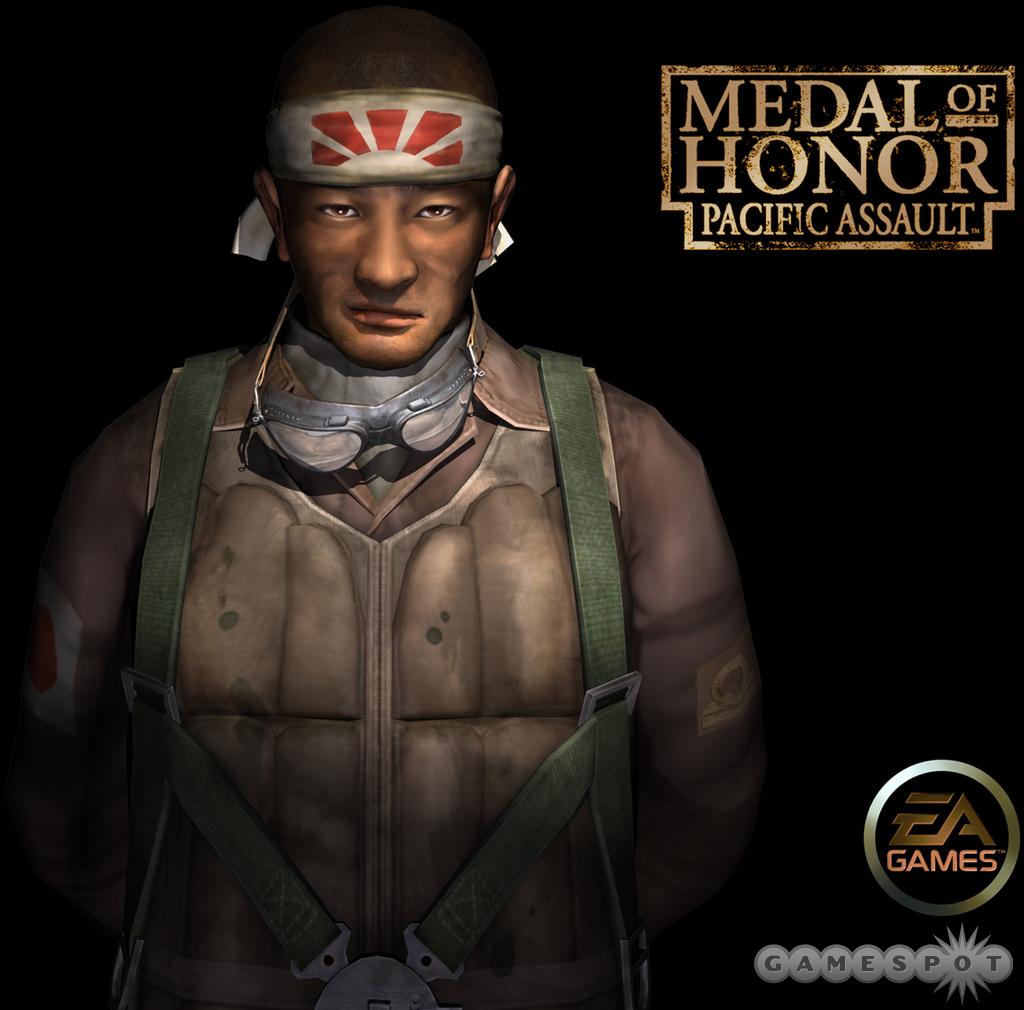Medal of Honor Pacific Assault Designer Diary #2
Senior Producer Brady Bell explains the huge amount of research and work required to make a Medal of Honor game.
At this point, it might feel like every aspect of World War II is well known to the general public, considering the huge number of World War II-based books, television shows, movies, and, yes, games that have been released in recent years. However, making a historically authentic World War II game still takes quite a bit of research. Electronic Arts publishes one of the most successful World War II-based series of games, Medal of Honor, which allows you to relive the intense battles of the war virtually. However, after a number of European-based Medal of Honor games for the PC and console, EA only recently turned toward the Pacific theater of operations. So, in many ways, the developers at EA had to start over in terms of research. In the latest edition of our designer diaries, Senior Producer Brady Bell was kind enough to provide us a glimpse of what goes into each and every Medal of Honor game.
Researching the Pacific
By Brady Bell
Senior Producer, Electronic Arts
Is authenticity really that important? How much research truly goes into a Medal of Honor game? When do you choose to take historical liberties? These are a few of the most common questions put to me, and in this segment, I'll attempt to walk you through how we approach a Medal of Honor game.
If you've read Rick Giolito's diary, you're now familiar with the franchise roots and its celebrity-rich beginnings. But as you might imagine, there's an ongoing, monumental effort behind the scenes to ensure that the foundation of our games is unwavering. It comes at a great cost in dollars, manpower, and time. It began in 1997, and thanks to Electronic Arts, it hasn't stopped for a single minute.
Why is authenticity important? In the case of Medal of Honor, we're re-creating a history that was frighteningly real for a generation of people. Imagine someone making an adventure story of your own life and screwing up all but the obvious points. You'd be upset, right? Now, if you're anything like me, you've done nothing in your life that compares to the contribution and sacrifice made by men and women during World War II. It was a dark period in the history of the world, and those who lived through it were changed forever. It's obviously not something that can be taken lightly. I know that I would personally be offended to have lived through the horrors of World War II only to see some punks making a game about it that glossed over the actual accounts. So, the answer is simple: Authenticity is important because we're morally obligated to the individuals who lived the history we're re-creating.
A World War II-era halftrack.
The second reason authenticity is important is, of course, the game experience. This is manifested in the details of each Medal of Honor game. It's true that anyone can slap "Most Authentic" on their game, and it can go largely unchecked. They can all (hopefully) get the location and date right, but nobody comes even remotely close to the amount of detail we strive for. We simply hold ourselves to a higher standard. The impact of authenticity is, of course, not unique to Medal of Honor or even to games. The attention to detail--and what I call "sum of the subtleties"--in your work is what makes all the difference. It goes unnoticed, it's gathered by your subconscious, and it greatly improves the experience--without you knowing it's there.
So just how much research actually goes into an MOH game? Well, let me walk you through the process on Pacific Assault. Understand that before I started working on this project, my level of knowledge about the Pacific theater of operations was--how should I put this--in the shallow end of the historical pool. We had been exclusively producing European theater of operations titles since inception, and around the time of Medal of Honor Allied Assault, I started a begging campaign to re-create the Pacific battles of WWII. Finally, my executive producer gave me the go-ahead to start preproduction on Medal of Honor Pacific Assault. Armed with my superficial knowledge of the Pacific theater of operations (Pearl, Midway, Iwo Jima, Guadalcanal, etc.), I was immediately terrified at the prospect of screwing up this killer opportunity. (The feeling never goes away, by the way.)
Fortunately, the floodgates opened, and the team dove into a research frenzy like none before it. Here's a portion of what we went through:
Designer Tom Hess gets a feel for a machine gun.
Medal of Honor Pacific Assault started with intensive reading and a weeklong visit to the National Archives in Washington DC, where we collected more than 50 hours of authentic battle footage. After digesting the bulk of this material, Dave Nash (the lead designer) and I began mapping out the game design. What locations do we want to re-create? Whose story do we want to tell? Where should the game start and end? This is the single most critical stage in developing a Medal of Honor game, and we never spent more time doing it than we did with Pacific Assault. Ultimately, the stars aligned, and it was clear: We were committed to showcasing the United States Marine Corps.
War is Research
Next we put on the brakes. (Stop right there!) Each time we choose a direction and feel great about moving forward, we immediately bring in our top adviser and military expert, Capt. Dale Dye (ret.), to verify that we are on the right track and that the experiences we hope to bring to life are on target. We walked Dale through our ideas, and, since he is a Marine himself, he was very excited with the direction we were headed. With our captain (literally) on board, we moved ahead.

With the branch of the armed forces and locations decided, we split into research teams and began stage three. Team members personally visited actual Pacific theater locations with Captain Dye, and they spent weeks scouting locations like Guadalcanal, Guam, Pearl Harbor, and more. Other team members participated in a World War II weapons shoot, which gave us real-life experience loading, firing, disassembling, cleaning, and reassembling every handheld weapon used in the game. (Understanding each weapon's weight, motion, sound, and overall effectiveness is pivotal in balancing the game.) Another group headed to the National Museum of the Pacific in Texas, where it took part in World War II reenactments--complete with functioning tanks and flamethrowers. (One of our guys got doused in fuel. Classic!) And our general studies of the war continue, never stopping, even as I write this.
When making a game that bears the name of and is endorsed by the Congressional Medal of Honor Society, all the research to this point is still considered cursory. It's here that our research goes wide and deep. One additional USMC military adviser, a World War II Japanese technical adviser, a pair of World War II museum curators, another National Archives researcher, and two weapons wranglers joined the effort. Capt. Dye began boot camp with the team, which consisted of class instruction on history, allied and enemy combat tactics, conduct, and a culminating paintball war where our team members had to utilize World War II tactics to win. (This part was really fun. Capt. Dye stood upright in the battlefield, screaming at everyone with pellets zipping past his head. He reminded me of Robert Duvall in Apocalypse Now. The guy is pretty hardcore.)
The developers learned how to disassemble and clean real weapons.
After months of fact-finding and fact-checking, we were ready to begin the most serious and rewarding research we undertake. Over several weeks, we interviewed dozens of World War II veterans from the Pacific theater. We heard their stories, and we asked a lot of questions. We were genuinely humbled to have spent time with them. A relationship developed, and, in fact, some of these guys even made suggestions for the game design! For example, a veteran named Tiny Renaker (called "Tiny" because he's nearly seven feet tall) spent an afternoon with us. Tiny is one of very few living World War II drill instructors. During his visit, he provided tons of insight, suggestions, and feedback on what we were planning for boot camp. I can honestly say that he personally made our game better. It's a unique, remarkable experience--one that reminds us how important it is to get it right.
This level of research continues all through development. As recently as last week, our art director needed reference on an airplane, and the books we had just didn't suffice. Immediately, several of us headed off to the Air Museum Planes of Fame museum in Chino, California, and spent the day photographing and filming every inch of an authentic SBD Dauntless from World War II (it still flies today).
Art Director Rob Stahl gets some tank time.
Is everything in Medal of Honor Pacific Assault 100-percent authentic? No...and we will never make that claim. First and foremost, we're game developers, so our number one priority is making the best possible game, period. Quite often, we're faced with the decision of authenticity versus gameplay, and with few exceptions, gameplay wins--no contest. Historical liberties are part of any entertainment, and Pacific Assault is no exception. What's really important, however, is arming ourselves with a breadth of historical knowledge so we can understand the implications of those decisions.
Got a news tip or want to contact us directly? Email news@gamespot.com

Join the conversation